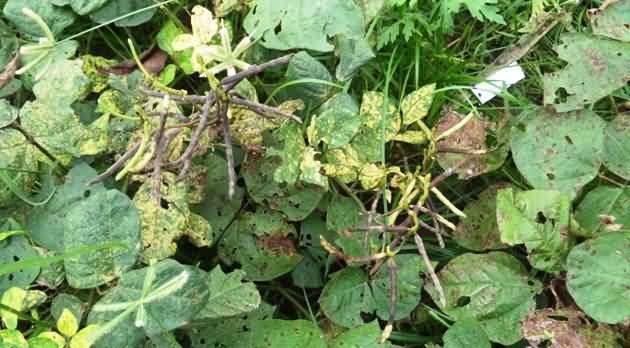मूंगबीन में पीला मोज़ेक रोग: एक प्रमुख संकट।
Mungbean belonging to family Fabaceae also called as greengram is one of the most important pulse crop grown and consumed in India. Providing one of the sources of protein for vegetarians.
In India this crops is widely growing in the area of Uttar Pradesh, West Bengal, Madhya Pradesh, Maharashtra, Rajasthan, Bihar, Andhra Pradesh and Haryana during kharif and rabi season (Singh et al 2014a).
Now a day this crop is tormenting a harsh abatement in the production due to astringent on rush of viral diseases. Among various viral diseases, Yellow Mosaic Disease (YMD) caused by different species of white-fly such as Bemisia tabaci transmitted geminivirus belonging to genus begomovirus is one of the most pestiferous disease in mungbean.
YMD was first reported in moongbean in India by Nariani, 1960. Main pathogens causing YMD in mungbean in India are MYMV and MYMIV. In lower Gangetic alluvial region, higher incidence of disease has been observed during summer due to favorable condition for multiplication of the vector Bemisia tabaci.
Host species and susceptibility of each plant affect the development of disease symptoms after virus infection (Singh et al 2014b).
Occurrence of YMD
Higher incidence of disease have been observed during spring and rainy season due to favorable condition for multiplication of the vector Bemisia tabaci in spring and rainy seasons. Diseased plant usually matures late. There is a positive correlation of whitefly population on 20 and 30 day crop and disease incidence at 45 days old crop with maximum temperatures (Murugesan et al., 1977).
In a survey in Gujarat by Pawer and Mahatma in 2013, cultivar GM-4 and K-851 were found more severely affected at the flowering stage during summer season. The variety Chinamung that covers maximum area in Karnataka was found susceptible to MYMV.
Yield loss in Mung bean due to YMD
Reduction of 9.6 to 38.2 percent in height, 7 to 28.5 percent in fresh weight of shoot and 4.3 to 22.1 percent in dry weight, 25.7 percent in 1000 seed weight of susceptible cultivar of mungbean was reported in a study by Premchand and Varma (1983).
Quaiser Ahmed (1991) reported a yield loss of 83.9 per cent and a maximum growth reduction of 62.94 per cent in Vigna radiata cv. Pusa baisakhi due to mungbean yellow mosaic gemini virus infection and concluded that early crop infection reduced yield more than late infection.
Symptoms of Yellow Mosaic Disease in Mung bean
In mungbean first symptoms of the disease appear on the young leaves in the form of mild scattered yellow specks or spots (Fig1.).
This disease starts after 3 weeks of plant life. The next trifoliate leaf emerging from the growing apex shows irregular yellow and green patches alternating with each other (Nariani, 1960).
The leaf size is generally not much affected but sometimes the green areas are slightly raised and the leaves show slight puckering and reduction in size. The size of yellow areas goes on increasing in the new growth and ultimately some of the apical leaves turn completely yellow.
The diseased plants usually mature late and bear very few flowers and pods. The size of the pod is reduced and more frequently immature and small sized seeds are obtained from the pods of diseased plants (Gautam, 1990).
Screening of MYMV in mungbean
To identify a stable source of resistance among the cultivated varieties a screening on large scale is needed and hence to deploy this durable sources of resistance toward MYMV tolerance in mungbean.
Habib et al 2007, developed a screening nursery comprising of 108 test entries and screening was done under natural environmental conditions in 2007 at University of the Punjab, Lahore, Pakistan against yellow mosaic disease (YMD).
All the test entries showed a highly susceptible response. Despite being highly susceptible, some test entries produced good yield and showed tolerance to YMD. Screening has also been achieved by using agroinoculation by karthikeyan et al 2011.
Major YMD resistant variety in India
The resistance to YMD disease in mungbean for a particular cultivar varies with the environment and place.
In various studies few cultivars reported resistance such as Narendra Mung1, Pant Mung 3, PDM 139 (Samrat), PDM-11(Spring Season), ML 131, ML 267, ML 337, Pusa 105, MUM 2, PANTMUNG1, PANT MUNG5, HUM12, PUSA9531, HUM1 and susceptible varieties such as TRAM 2, KOPERGAON3, TAP7, SML134 and SML 668.
Yellow Mosaic Disease Management strategy
- Opt for resistant varieties as per recommendation of local agricultural authorities.
- Diseased plants should be rogued out to prevent further spread of the disease.
- In order to prevent whitefly (Bemisia ) infestation spray with triazophos 40 EC @ 2.0 ml/l or malathion 50 EC @ 2.0 ml/l or oxydemeton methyl 25 EC @ 2.0 ml/l at 10-15 days intervals if required.
- Application of Fungicide: Mycotal, Tracer and Imidacloprid were applied to manage the whitefly population and MBYMV. The data of MBYMV and its vector as influenced by Mycotal, Tracer and Imidacloprid treatments was recorded.
- Development of YMV-tolerant mungbean variety: Development of YMV-tolerant variety is of prime importance for stabilizing the yield levels. Introduction of YMV-tolerant pulses in the farmer's field will circumvent the problems associated with the residual effects of the insecticides/ pesticides in the soil.

Fig1. Mungbean leaves showing symptoms of Yellow Mosaic Disease
Authors:
Nidhi Singh, Joyashree Mallick, Hemlata Singh
Bidhan Chandra Krishi Vishwavidyalaya , Mohanpur-741252, West Bengal
email:
